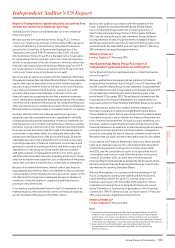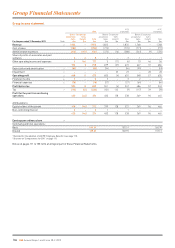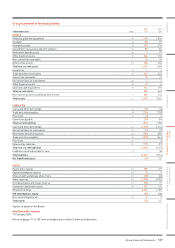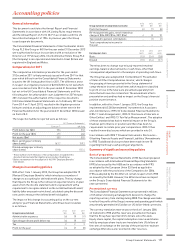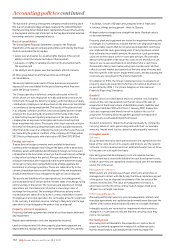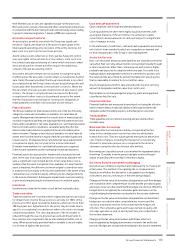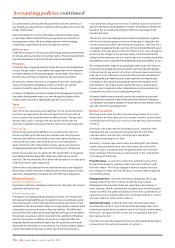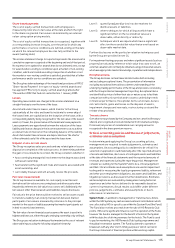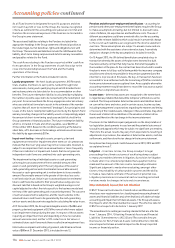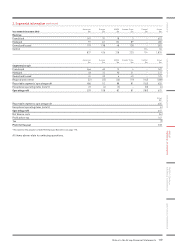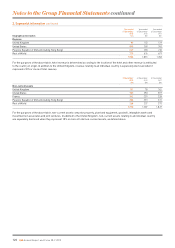Holiday Inn 2013 Annual Report Download - page 114
Download and view the complete annual report
Please find page 114 of the 2013 Holiday Inn annual report below. You can navigate through the pages in the report by either clicking on the pages listed below, or by using the keyword search tool below to find specific information within the annual report.
The functional currency of the parent company remains sterling since
this is a non-trading holding company located in the United Kingdom
that has sterling denominated share capital and whose primary activity
is the payment and receipt of interest on sterling denominated external
borrowings and inter-company balances.
Basis of consolidation
The Consolidated Financial Statements comprise the Financial
Statements of the parent company and entities controlled by the Group.
Control exists when the Group has:
• power over an investee (i.e. existing rights that give it the current
ability to direct the relevant activities of the investee);
• exposure, or rights, to variable returns from its involvement with
the investee; and
• the ability to use its power over the investee to affect its returns.
All intra-group balances and transactions are eliminated
onconsolidation.
The assets, liabilities and results of those businesses acquired or
disposed of are consolidated for the period during which they were
under the Group’s control.
The Group operates a deferred compensation plan in the US
which allows certain employees to make additional provision for
retirement, through the deferral of salary with matching company
contributions. Employees can draw down on the plan in certain limited
circumstances during employment. The assets of the plan are held
in a company-owned trust which is not consolidated as the relevant
activity of the trust, being the investment of the funds in the trust,
is directed by the participating employees of the plan and the
company has no exposure to the gains and losses resulting from
those investment decisions. The assets of the trust are held solely for
the benefit of the participating employees and to pay plan expenses,
other than in the case of a company insolvency in which case they can
be claimed by the general creditors of the company. At 31 December
2013, the trust had assets with a fair value of $135m (2012 $113m).
Foreign currencies
Transactions in foreign currencies are translated to functional
currency at the exchange rates ruling on the dates of the transactions.
Monetary assets and liabilities denominated in foreign currencies are
retranslated to the functional currency at the relevant rates of exchange
ruling on the last day of the period. Foreign exchange differences
arising on translation are recognised in the income statement except
on foreign currency borrowings that provide a hedge against a net
investment in a foreign operation. These are taken directly to the
currency translation reserve until the disposal of the net investment,
at which time they are recycled against the gain or loss on disposal.
The assets and liabilities of foreign operations, including goodwill,
are translated into US dollars at the relevant rates of exchange ruling
on the last day of the period. The revenues and expenses of foreign
operations are translated into US dollars at average rates of
exchange for the period. The exchange differences arising on the
retranslation are taken directly to the currency translation reserve.
On disposal of a foreign operation, the cumulative amount recognised
in the currency translation reserve relating to that particular foreign
operation is recycled against the gain or loss on disposal.
Property, plant and equipment
Property, plant and equipment are stated at cost less depreciation and
any impairment.
Repairs and maintenance costs are expensed as incurred.
Land is not depreciated. All other property, plant and equipment are
depreciated to a residual value over their estimated useful lives, namely:
• buildings – lesser of 50 years and unexpired term of lease; and
• fixtures, fittings and equipment – three to 25 years.
All depreciation is charged on a straight-line basis. Residual value is
re-assessed annually.
Property, plant and equipment are tested for impairment when events
or changes in circumstances indicate that the carrying value may not
be recoverable. Assets that do not generate independent cash flows
are combined into cash-generating units. If carrying values exceed
their estimated recoverable amount, the assets or cash-generating
units are written down to the recoverable amount. Recoverable
amount is the greater of fair value less costs to sell and value in use.
Value in use is assessed based on estimated future cash flows
discounted to their present value using a pre-tax discount rate that
reflects current market assessments of the time value of money and
the risks specific to the asset. Impairment losses, and any subsequent
reversals, are recognised in the income statement.
On adoption of IFRS, the Group retained previous revaluations of
property, plant and equipment which are included at deemed cost
as permitted by IFRS 1 ‘First-time Adoption of International
Financial Reporting Standards’.
Goodwill
Goodwill arises on consolidation and is recorded at cost, being the
excess of the cost of acquisition over the fair value at the date of
acquisition of the Group’s share of identifiable assets, liabilities and
contingent liabilities. With effect from 1 January 2010, transaction
costs are expensed and therefore not included in the cost of
acquisition. Following initial recognition, goodwill is measured at
cost less any accumulated impairment losses.
Goodwill is tested for impairment at least annually by comparing
carrying values of cash-generating units with their recoverable
amounts. Impairment losses cannot be subsequently reversed.
Intangible assets
Software
Acquired and internally developed software are capitalised on the
basis of the costs incurred to acquire and bring to use the specific
software. Costs are amortised over estimated useful lives of three
to five years on a straight-line basis.
Internally generated development costs are expensed unless
forecast revenues exceed attributable forecast development costs,
in which case they are capitalised and amortised over the estimated
useful life of the asset.
Management contracts
When assets are sold and a purchaser enters into a franchise or
management contract with the Group, the Group capitalises as part
of the gain or loss on disposal an estimate of the fair value of the
contract entered into. The value of management contracts is
amortised over the life of the contract which ranges from six to
50 years on a straight-line basis.
Other intangible assets
Amounts paid to hotel owners to secure management contracts and
franchise agreements are capitalised and normally amortised over the
shorter of the contracted period and 10 years on a straight-line basis.
Intangible assets are reviewed for impairment when events or
changes in circumstances indicate that the carrying value may
not be recoverable.
Borrowing costs
Borrowing costs attributable to the acquisition or construction of
property, plant and equipment or in respect of software projects
that necessarily take a substantial period of time to prepare for
112 IHG Annual Report and Form 20-F 2013
Accounting policies continued



